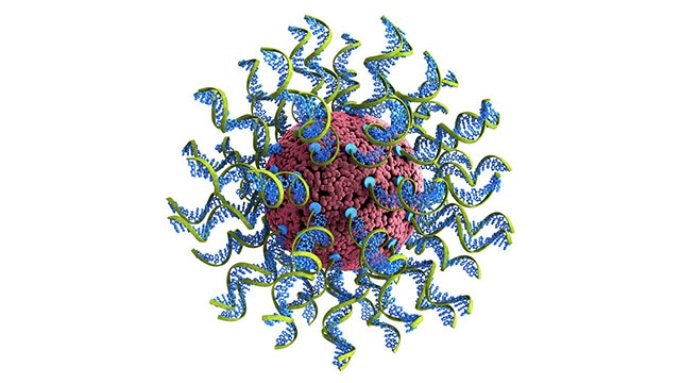Feb 20 2019
Spherical nucleic acids, or SNAs in short, have the potential to treat a wide range of diseases. These acids are set to transform medicine. However, researchers have to improve the numerous components of these digitally designed nanostructures before these can achieve their full potential.
 SNAs are ball-like forms of DNA and RNA arranged on the surface of a nanoparticle. (Image credit: Chad Mirkin/Northwestern University)
SNAs are ball-like forms of DNA and RNA arranged on the surface of a nanoparticle. (Image credit: Chad Mirkin/Northwestern University)
Headed by nanotechnology pioneer Chad A. Mirkin, researchers at Northwestern University have created a direct route to improve these complex particles, which may soon make them a practical treatment option for neurological disorders, genetic diseases, different forms of cancer, and more.
Spherical nucleic acids represent an exciting new class of medicines that are already in five human clinical trials for treating diseases, including glioblastoma (the most common and deadly form of brain cancer) and psoriasis.
Chad A. Mirkin, George B. Rathmann Professor of Chemistry, Weinberg College of Arts and Sciences, Northwestern University.
The SNAs were invented by Mirkin.
The latest research published recently in Nature Biomedical Engineering describes the optimization technique, in which machine learning and a library approach are used to quickly produce, determine, and examine the properties and activities of SNA structures. The process, in which over 1000 structures were screened at a time, was helped by SAMDI-MS technology, devised by Milan Mrksich, study co-author and Henry Wade Rogers Professor of Biomedical Engineering in McCormick School of Engineering at Northwestern University. Mrksich is also the director of the Center for Synthetic Biology.
SNAs were invented and created at Northwestern University. These nanostructures contain ball-like forms of RNA and DNA organized on a nanoparticle’s surface. SNAs can be digitally designed by researchers to be accurate, personalized treatments that switch off cellular activity and genes, and more lately, as vaccines stimulating the immune system of the body to treat a host of diseases, including specific forms of cancer.
It has been challenging to optimize SNAs because their specialized structures—including DNA sequence, particle composition and size, and the inclusion of other kinds of molecular components—can differ in several ways, enhancing or affecting their efficacy in stimulating an immune response. This new method showed that structural variation results in biological activities demonstrating interdependent and non-obvious contributions to the SNAs’ efficacy. Since no predictions were made on these relationships, it is possible that they may not have been detected in a regular study of a minute set of structures. For instance, the potential to trigger an immune response can rely on the size of a nanoparticle, composition and/or the way DNA molecules are oriented on the surface of the nanoparticle.
With this new information, researchers can rank the structural variables in order of importance and efficacy, and help establish design rules for SNA effectiveness.
Andrew Lee, Study Co-Author and Assistant Professor, Department of Chemical and Biological Engineering, McCormick School of Engineering, Northwestern University.
“This study shows that we can address the complexity of the SNA design space, allowing us to focus on and exploit the most promising structural features of SNAs, and ultimately, to develop powerful cancer treatments,” Mirkin stated, who is also director of the International Institute for Nanotechnology.
“Addressing Nanomedicine Complexity with Novel High-Throughput Screening and Machine Learning” is the title of the Nature Biomedical Engineering paper. Neda Bagheri, Gokay Yamankurt, Eric J. Berns, and Albert Xue, of Northwestern University, are other coauthors of the study.
The study was performed as part of the Northwestern University Center for Cancer Nanotechnology Excellence (Northwestern CCNE), an association between the Robert H. Lurie Comprehensive Cancer Center and the IIN, that is exclusively dedicated on applying SNAs to develop advanced cancer treatments. A grant from the National Cancer Institute (NCI) funded the program.